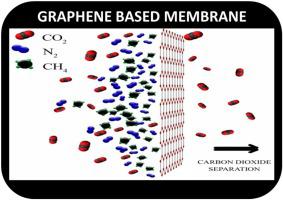Journal of CO2 Utilization ( IF 7.2 ) Pub Date : 2021-04-30 , DOI: 10.1016/j.jcou.2021.101544 Swati Singh , Anish Mathai Varghese , Donald Reinalda , Georgios N. Karanikolos

|
A significant portion of the global energy is nowadays dedicated to separation and purification processes, most of which exhibit limited efficiency mainly due to thermodynamic limitations. As an alternative, membrane-based technologies show increasing potential due to the fact that membranes can combine selective separation at the molecular level, energy-efficient operation, and cost effectiveness. Membranes can be applied in various fields that involve liquid and gas separation such as water desalination and treatment, air purification, gas sweetening, and carbon dioxide capture/separation. Ability to develop a variety of membranes, establish new synthesis approaches, involve suitable materials and composites, and thoroughly study the resulting membrane characteristics with holistic experimental and theoretical toolsets are critical toward enhancing performance efficiency and enabling scalability. Membrane application in liquid mixture separations, such as desalination and water treatment, is well integrated into the industrial practice, yet in separation of gases and particularly mixtures involving CO2, there is still a long way to go until significant industrial integration is implemented. Lately, the fascinating graphene has been evolved into fabrication of CO2 separation membranes often exhibiting superior performance and fundamentally interesting gas transport phenomena from macroscopic to molecular scale. This work aims to showcase and critically review up to date advances in graphene-based membranes for CO2 separation, by visiting synthesis approaches, separation and gas transport mechanisms, and membrane types including inorganic, hollow fiber and mixed matrix ones. The review intends to be a useful reference for those investigating CO2 separation using membrane technologies targeting capture from various emission sources and purification before conversion/utilization.
中文翻译:

石墨烯基膜用于二氧化碳分离
如今,全球能源中有很大一部分专用于分离和纯化过程,其中大部分效率有限,主要是由于热力学限制。作为替代方案,基于膜的技术由于膜可以在分子水平上结合选择性分离,节能运行和成本效益这一事实而显示出越来越大的潜力。膜可用于涉及液体和气体分离的各种领域,例如水脱盐和处理,空气净化,气体脱硫和二氧化碳捕获/分离。能够开发各种膜,建立新的合成方法,使用合适的材料和复合材料,并使用整体实验和理论工具集全面研究所得膜的特性,对于提高性能效率和实现可扩展性至关重要。在液体混合物分离(例如脱盐和水处理)中膜的应用已很好地集成到工业实践中,但在气体尤其是涉及CO的混合物的分离中如图2所示,要实现重大的工业整合还有很长的路要走。最近,令人着迷的石墨烯已经发展成为制造CO 2分离膜的过程,通常表现出卓越的性能以及从宏观到分子尺度的基本有趣的气体传输现象。这项工作旨在通过参观合成方法,分离和气体传输机制以及包括无机,中空纤维和混合基质在内的膜类型,展示并批判性地回顾用于CO 2分离的石墨烯基膜的最新进展。该审查旨在为那些研究CO 2的人提供有用的参考 使用膜技术进行分离,目标是从各种排放源捕获并在转化/利用之前进行纯化。











































 京公网安备 11010802027423号
京公网安备 11010802027423号